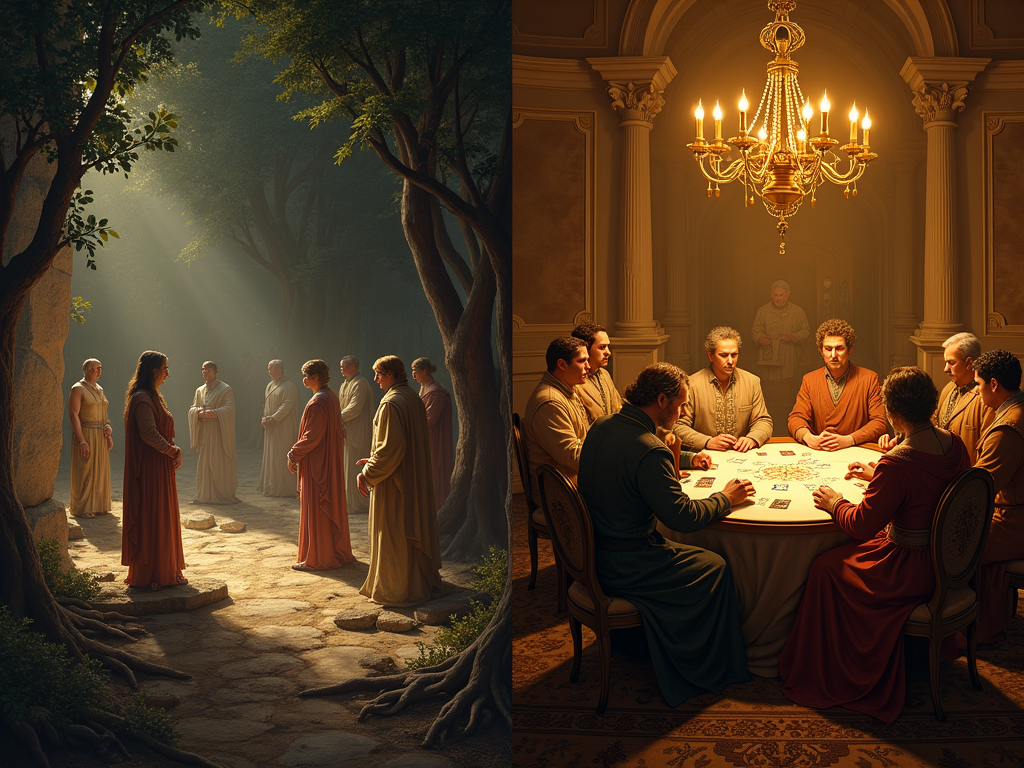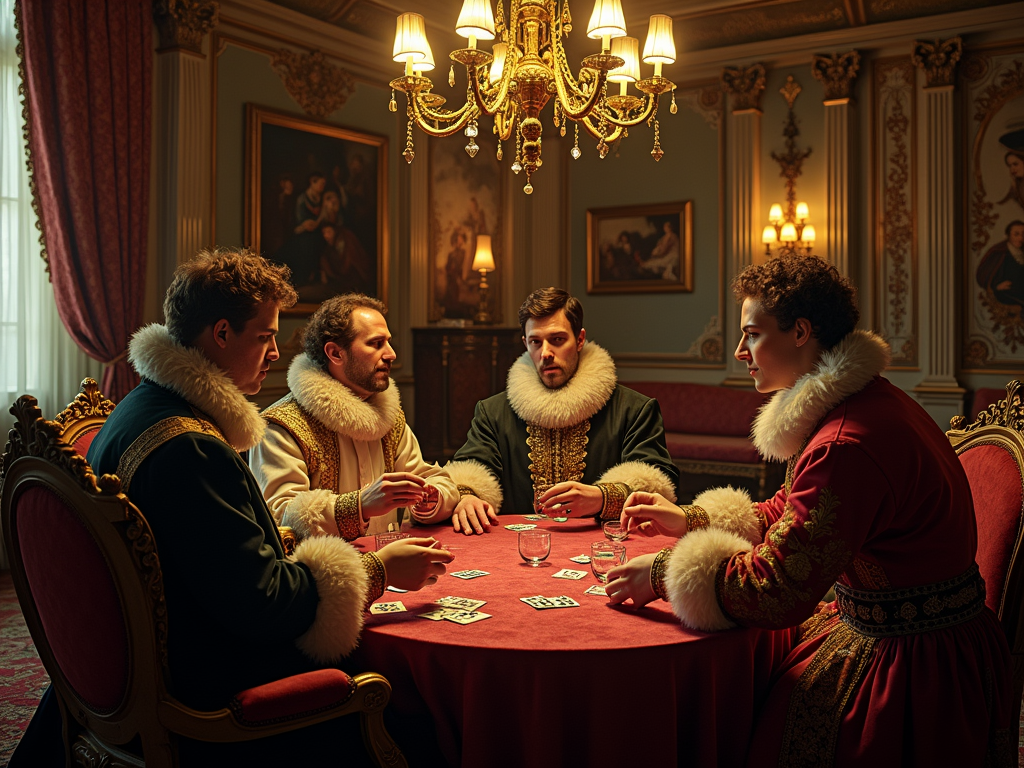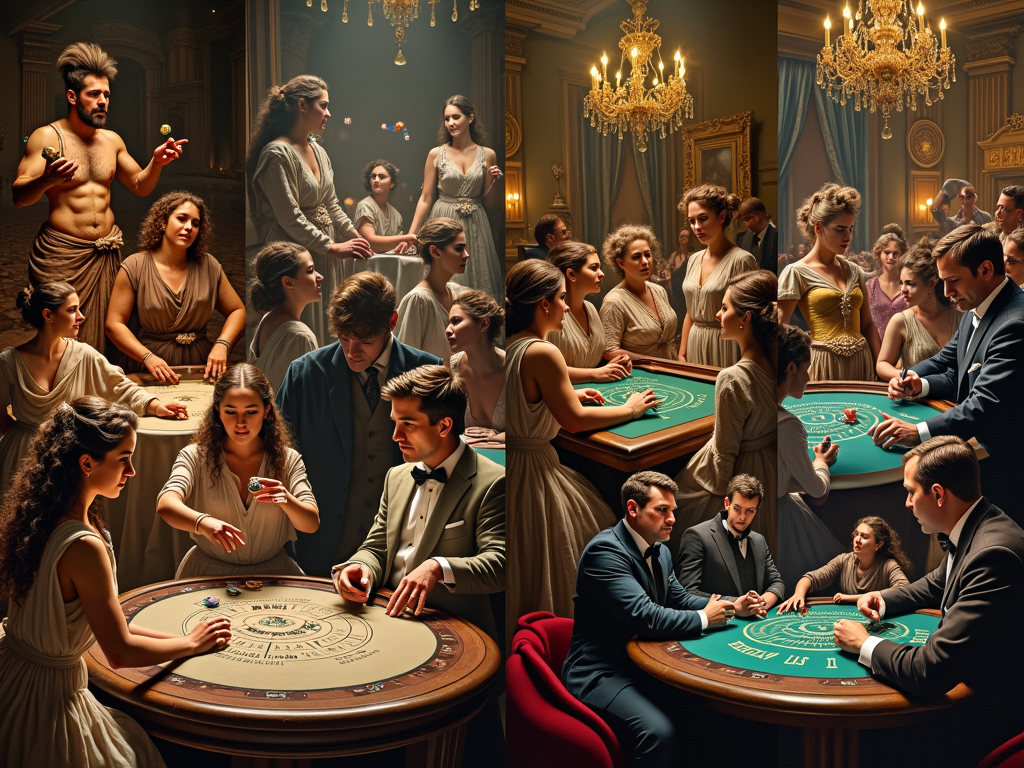The Evolution of Baccarat: From Ancient Rites to Casino Royalty
Baccarat’s path from ancient Etruscan ceremonies to modern casino floors shows an incredible evolution of gaming culture. Ancient Italian religious practices with nine-sided dice sparked the creation of a card game that later captivated French nobility and spread across elite social circles before becoming a prominent casino attraction.
Key Takeaways
- Felix Falguierein adapted the traditional Etruscan ritual into a card game in 15th century Italy
- French aristocrats refined the Italian version into “Chemin de Fer,” adding social dynamics and rotating banker positions
- Punto Banco, the modern casino variant, first appeared in South America before taking root in Las Vegas in 1959
- Ian Fleming’s portrayal of James Bond playing Baccarat in Casino Royale established the game’s sophisticated reputation
- Baccarat now drives substantial profits in major gambling destinations, with particular success in Asian markets like Macau
The game’s simple rules paired with its refined atmosphere create an appealing mix of accessibility and elegance. This combination has helped Baccarat maintain its status as a premier casino game, especially popular among high-stakes players.
A Personal Perspective
My experience with Baccarat spans both traditional and modern variants. The game’s enduring appeal lies in its perfect balance of chance and strategy, making each hand an engaging experience regardless of skill level.
The historical connection to nobility adds an extra layer of intrigue to every game, while modern casinos have successfully preserved its distinguished character. Asian markets, in particular, have embraced Baccarat’s blend of tradition and excitement, making it a cornerstone of their gaming culture.
From Ancient Rituals to Modern High-Stakes: Baccarat’s Italian Roots
From Sacred Rituals to Card Game Evolution
I can trace Baccarat’s fascinating roots back to an intriguing Etruscan ritual where a virgin’s fate hung on the roll of a nine-sided die. The ritual’s scoring system bears striking similarities to modern Baccarat — rolling an 8 or 9 earned priestess status, while 6 or 7 led to banishment, and lower numbers spelled death.
The game as we know it today emerged in 15th century Italy through Felix Falguierein’s innovative mind. He transformed these ancient numerical traditions into an engaging card game, initially using Tarot cards rather than the standard 52-card deck that’s common in modern Baccarat.
The name itself tells a story — derived from the Italian word “Baccara,” meaning zero, it reflects one of the game’s key features: face cards hold no value. This simple yet strategic element has remained constant through centuries of play, creating a perfect balance of chance and skill that’s kept players coming back for generations.
Let me share the key transformations that shaped Baccarat’s early development:
- The shift from Tarot cards to standard playing cards made the game more accessible
- The scoring system evolved while maintaining the significance of 8 and 9 as winning numbers
- Face cards’ zero value carried over from Italian traditions
- The game spread from Italian salons to wider European audiences
This blend of mystical origins and mathematical precision helped Baccarat gain popularity among Italian nobility, setting the stage for its eventual rise in French aristocratic circles. The game’s transition from ancient religious ceremony to sophisticated card game shows how deeply rooted gambling traditions can be in cultural practices.

How the French Nobility Transformed Baccarat
From Italian Import to French Innovation
The Franco-Italian War marked a pivotal moment for baccarat’s journey into France, as King Charles VIII’s troops brought back more than just military victories between 1494 and 1559. The card game quickly captured the attention of French nobles, who saw its potential for sophisticated entertainment. The aristocracy didn’t just adopt the game – they revolutionized it.
The Birth of Chemin de Fer
French ingenuity led to the creation of “Chemin de Fer”, a dramatic departure from the original Italian version. This variant introduced several key innovations that made the game more engaging and socially interactive. The most significant change was the shift from playing against the house to players competing directly with each other.
Here are the distinctive features that made Chemin de Fer unique:
- Players took turns serving as the banker, creating a more dynamic and equal playing field
- The rotating banker role added an extra layer of strategy and social interaction
- Participants could choose whether to accept the banker position or pass it along
- The game featured strict ritualistic elements that appealed to the nobility’s sense of ceremony
The French aristocracy embraced baccarat with particular enthusiasm in their private salons. These exclusive gaming rooms became sanctuaries where nobles could engage in high-stakes play away from public view. The intimate setting of these salons fostered an atmosphere of refinement and discretion that perfectly suited the aristocracy’s tastes.
The social aspect of Chemin de Fer proved particularly appealing. Rather than facing an impersonal house, players engaged directly with their peers, making each game a sophisticated social event. This format encouraged conversation, strategy, and the building of relationships among the elite, transforming baccarat from a simple card game into an essential element of French high society.

The Birth of Modern Casino Baccarat
The Evolution of Banking Systems
A significant shift in Baccarat’s history came with the introduction of “Baccarat Banque,” which changed how the game was played. Instead of players taking turns as the banker like in Chemin de Fer, this variant featured a permanent banker position. This change laid the groundwork for the casino-style game we know today.
The next major development happened in South America, where “Punto Banco” emerged in Cuba and Argentina. This version transformed Baccarat into a house-banked game, making it more suitable for casino operations. The betting became straightforward, with fixed rules guiding every decision.
The Las Vegas Revolution
The modern era of Baccarat truly began in 1959 when the Sands Casino brought Punto Banco to Las Vegas. This version stripped away the complex decision-making of earlier variants while maintaining the game’s core excitement. I’ve seen how this simplified version makes the game more accessible to new players through three main betting options:
- Player (Punto) – A bet on the player’s hand to win
- Banker (Banco) – A bet on the banker’s hand to win
- Tie – A bet that both hands will have equal values
The casinos didn’t forget Baccarat’s prestigious heritage. They created exclusive high-limit rooms, complete with private dealing areas and refined service standards. These special spaces helped maintain the game’s reputation as a favorite among high rollers and luxury-seeking players.
The influence of modern casino Baccarat extends beyond its rules. By creating an atmosphere of sophistication around the game, casinos have successfully preserved its appeal to players seeking both entertainment and status. The private gaming areas, professional dealers, and upscale amenities all contribute to an experience that feels special and exclusive.
James Bond’s Favorite Game: Baccarat in Popular Culture
Bond’s High-Stakes Card Game
James Bond’s sophisticated persona and Baccarat share a deep connection that has shaped how people view this classic card game. Ian Fleming’s decision to make Baccarat Bond’s preferred casino game, particularly in “Casino Royale,” wasn’t just a random choice – it perfectly matched 007’s refined character and penchant for high-stakes situations.
From Elite Tables to Pop Culture Icon
The specific version of Baccarat featured in Bond’s adventures was Chemin de Fer, the original European variant that still carries an air of exclusivity. This choice helped establish Baccarat as more than just a card game – it became a symbol of luxury, intrigue, and calculated risk-taking.
Here’s how Bond’s association elevated Baccarat’s status:
- The game became linked with international espionage and glamorous locations
- It reinforced Baccarat’s reputation as a game for sophisticated players
- The high-stakes scenes in Casino Royale highlighted the game’s dramatic potential
- Bond’s strategic approach to Baccarat showcased it as a game of skill and nerve
The impact of Fleming’s work transformed Baccarat from an aristocratic pastime into a cultural touchstone. The game’s appearance in various Bond adaptations across books and films has kept it relevant for new generations, preserving its mystique while making it more accessible to curious players.
The tension-filled Baccarat scenes in Bond stories have done more than entertain – they’ve educated audiences about the game’s basics and its appeal. This cultural exposure helped Baccarat transition from exclusive European salons to a wider audience, while maintaining its reputation for elegance and sophistication.
Global Gaming Evolution: From Private Salons to Casino Floors
The Journey Across Continents
Baccarat’s path from exclusive European salons to worldwide popularity started with its arrival in England’s sophisticated gambling circles. The game caught on quickly with the British upper class, who appreciated its blend of chance and strategy. As European immigrants crossed the Atlantic, they brought their cherished card games, including Baccarat, to North American shores.
In North America, Punto Banco emerged as the preferred variant, offering a streamlined version that appealed to casino operators and players alike. The game’s straightforward nature – bet on the Player, Banker, or Tie – made it accessible while maintaining its sophisticated appeal.
Modern Casino Integration
Modern casinos have preserved Baccarat’s exclusive character by creating dedicated high-limit rooms. These private spaces cater to high rollers who enjoy making substantial wagers in a more intimate setting. The special treatment extends to personalized service, premium amenities, and higher betting limits than those found on regular casino floors.
I’ve noticed that Baccarat’s popularity has surged significantly in major gaming destinations. Here’s where the game particularly shines:
- Macau casinos, where it generates over 80% of gaming revenue
- Las Vegas Strip properties, featuring elaborate Baccarat lounges
- Atlantic City’s high-limit areas, attracting international players
- Singapore’s integrated resorts, catering to Asian high rollers
The game’s enduring appeal stems from several key factors that keep players coming back:
- Quick rounds that maintain excitement
- Simple rules that don’t require complex strategy
- Low house edge compared to many other casino games
- Atmosphere of sophistication and luxury
- Privacy and personal attention in dedicated gaming areas
https://www.youtube.com/watch?v=s_vpMd2P1cg&pp=0gcJCU8JAYcqIYzv
Sources:
Parlett, David. The Penguin Book of Card Games.
Scarne, John. Scarne’s New Complete Guide to Gambling.
Bicycle Cards. “How to Play Baccarat”
Casino.org. “The History of Baccarat”
Britannica. “Baccarat – card game”





